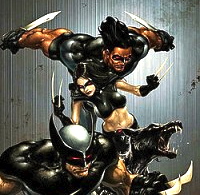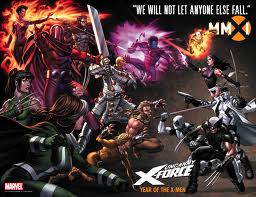X-Force

Cable and X-Force #7 Review – Daddy’s Home
Viewer Question: What have been some of your favorite covers of the last few months?
B3 Comics reviews and discusses Cable and X-Force #7!
X-Force  Cover art for X-Force, vol. 3 #1 Art by Clayton Crain
Cover art for X-Force, vol. 3 #1 Art by Clayton Crain
X-Force is a fictional Marvel Comics superhero team, one of several spin-offs of the popular X-Men franchise, and the eponymous subject of the X-Force comic book series. Conceived by writer/illustrator Rob Liefeld, the team was formed in New Mutants, vol. 1 #100 (April 1991) and soon afterwards was featured in its own series. The group was a new incarnation of the 1980s team, the New Mutants. Led by themutant Cable, X-Force was more militant and aggressive than the X-Men. The X-Force series was successful in the early 1990s, but its popularity waned after Liefeld left, causing Marvel to implement several reforms to the title from 1995 until 2001 with varying degrees of success. Low sales on the X-Force series eventually prompted Marvel to revamp the title in 2001 with a new cast in the form of a group of self-interested young mutants who were gathered together by a corporation to become media stars and used the name X-Force. X-Force, vol. 1 was canceled with #129 and relaunched as X-Statix, which featured the later incarnation of the team. After X-Statix was canceled with #26, Marvel reunited the original X-Force team for a six-issue 2004 miniseries plotted and drawn by Liefeld. In 2007–2008, during the Messiah Complex crossover, a new version of the X-Force team was formed that had Wolverine leading a more militaristic black ops branch of the X-Men, forming the basis for a new X-Force series starting February 2008 by writers Craig Kyle and Christopher Yost, plus Clayton Crain as the artist. The series came to a conclusion in September 2010 as part of the Second Coming storyline that ran through various X-titles. The title was then relaunched in October 2010 as Uncanny X-Force with Rick Remender and Jerome Opeña as the creative team and Wolverine, Psylocke, Deadpool, Archangel, Fantomex, and E.V.A. as the initial roster. The series would end at issue #35 in 2012 and be once again relaunched as Uncanny X-Force Volume 2 as part of Marvel NOW!. A concurrent X-Force book, Cable and X-Force, is also being released at the same time.
X-Force Volume 1: 1991-2001 – Liefeld period
X-Force was created by illustrator Rob Liefeld after he started penciling the New Mutants, vol. 1 comic book in 1989 with #86. The popularity of Liefeld’s art led to him taking over the writing and drawing duties on the book, which allowed him to introduce Cable and several other new hard-edged characters in 1990 and 1991. With help from writer Fabian Nicieza, who provided the dialogue for Liefeld’s plots, Liefeld transformed the New Mutants into X-Force in New Mutants, vol. 1 #100, the book’s final issue. Liefeld and Nicieza launched X-Force, vol. 1 in August 1991. Rob Liefeld obtained the name for the series from an unknown artist at a convention a few months prior to its release. With the aid of a multiple-variant poly-bagged card, the book sold a record 5 million copies, and remains the second highest selling American comic book of all time, surpassed only by Jim Lee’s X-Men book that same summer with 8 million copies. The original line-up of the team included Boom Boom, Cable, Cannonball, Domino, Feral, Shatterstarand Warpath. In later issues, X-Force’s roster would include Siryn, Rictor and Sunspot. The main opponents of X-Force during its first year were the terrorist Mutant Liberation Front, led by Stryfe, a masked mutant with a mysterious link to Cable. Early issues also featured the wise-cracking mercenary Deadpool, the immortal Externals, and a new version of the Brotherhood of Mutants. Propelled by Liefeld’s art, X-Force became one of Marvel’s bestselling comic books immediately after its debut. The series rivaled The Amazing Spider-Manand Uncanny X-Men in popularity, particularly with the adolescent demographic. Toy Biz responded to X-Force’s popularity by introducing an X-Force action figure line alongside its X-Men action figure line. Liefeld illustrated the series up to #9 and stopped plotting it after #12 as Liefeld had become increasingly frustrated that he did not own the characters he created and that his art was being used on a variety of merchandise while he received little royalties. Along with six other popular Marvel artists, Liefeld left Marvel Comics in 1992 to form Image Comics.
X-Force continued with Nicieza writing and Greg Capullo illustrating. Nicieza, who also wrote X-Men, vol. 2, helped plot the X-Cutioner’s Song storyline that overlapped into most X-Men related books in the fall of 1992. In that story, Stryfe frames Cable for an assassination attempt on the X-Men’s founder Professor X, leading to a clash between the X-Men and X-Force. The crossover boosted Cable’s popularity, despite the character’s apparent death in X-Force #18, leading to his own solo series being launched in 1993. After X-Cutioner’s Song, X-Force continued under Nicieza and Capullo, and later pencilled by Tony Daniel. Having temporarily lost their leader, X-Force attempted to develop an identity of their own. The team gradually developed into a dysfunctional family after Cable’s return in #25, and the title regularly combined soap opera plot threads, such as romance and Siryn’s alcoholism, with violent action. Nicieza fleshed out previously unknown elements of each character’s history, including Siryn’s family in Ireland, Rictor’s in Mexico, and Cannonball’s in Kentucky, as well as the mysterious origins of Shatterstar. This period also saw the reintroduction of characters from the group’s New Mutants days, such as Rusty and Skids, Danielle Moonstar, and Cypher and Wolfsbane. A long-simmering sub-plot about Reignfire and the disappearance of Sunspot came to a climax just as the book went on hiatus for the Age of Apocalypse crossover event in 1995. Due to falling sales, X-Force emerged from the Age of Apocalypse event with a new creative team of writer Jeph Loeb and illustrator Adam Pollina, who significantly revised the team with issue #44. Loeb introduced new team uniforms, had the team move in with the X-Men at the X-Mansion, and placed emphasis on character-driven stories with fewer fight scenes. Rictor quit the team and Cannonball joined the X-Men. Caliban, a super-strong albino mutant who possessed the mind of a child, joined the team. Loeb’s stories included revelations about Shatterstar’s origin and the transformation of Boomer (formerly Boom Boom) into the more aggressive Meltdown. Fan response was generally positive.
Post-Cable period
In 1997, writer John Francis Moore, portrayed the team as carefree walkers exploring the open road and had X-Force break away from Cable and the X-Men. The roster of that incarnation was Meltdown, Siryn, Sunspot, Warpath, and Danielle Moonstar. In 1998, Moore and new artist Jim Cheung had X-Force move to a new headquarters in San Francisco, returned Cannonball and later Domino to the team, and added Bedlam, a mutant who could disrupt electronic equipment. However, towards the end of this run, sales on the title began to fall drastically. Writer Warren Ellis, who was known for his dark, cynical style, revamped three books, (X-Force, Generation X, and X-Man), as part of the Revolution revamp of the X-Men series of titles in 2000. Ellis’ stint on X-Force, co-written by Ian Edginton and illustrated by Whilce Portacio, saw Bedlam, Cannonball, Meltdown, and Warpath become a covert ops superhero team under the leadership of Pete Wisdom, a British mutant and former intelligence agent who could shoot burning blades of energy from his fingers. Sales remained about the same despite the changes in creators.
In early 2001, the X-Force title was completely reimagined by writer Peter Milligan and artist Mike Allred, who replaced the existing incarnation of the team with an entirely different group of mutants using the X-Force name. In X-Force, vol. 1 #115, Bedlam, Cannonball, Meltdown, and Warpath all appeared to die in an explosion, though all subsequently returned. The next issue, #116, saw the introduction of a new, sardonically toned X-Force consisting of colorfully dressed and emotionally immature young mutants put together and marketed to be media superstars. X-Force was canceled with #129 in late 2002 and replaced with the retitled X-Statix series in late 2002. In 2004, Marvel released a new six-issue X-Force miniseries, once again plotted and illustrated by Liefeld, with dialogue by Nicieza, that gathered many of the characters featured in the first X-Force, to critical panning yet decent sales. Some controversy arose from Liefeld’s insertion of over ten pages from previous unpublished comic books (Weapon X and Cable: First Contact) with word balloons edited to make them fit the X-Force storyline. It was subsequently followed with a four-issue prequel X-Force: Shatterstar miniseries.
A new X-Force ongoing series was launched in February 2008, written by Craig Kyle and Christopher Yost and drawn by Clayton Crain. Cyclops forms a black ops incarnation of X-Force that uses lethal force to permanently deal with threats against mutants.Warpath, Wolfsbane, Wolverine and X-23 form the starting lineup, with Angel, Domino and Elixir joining soon after. Yost had at one point stated that Deadpool would join the cast to bring more diversity to the team, but this did not happen until after his run and the launch of Uncanny X-Force. Over the Course of the volume at least 18 characters got killed off and 3 were long time characters.






